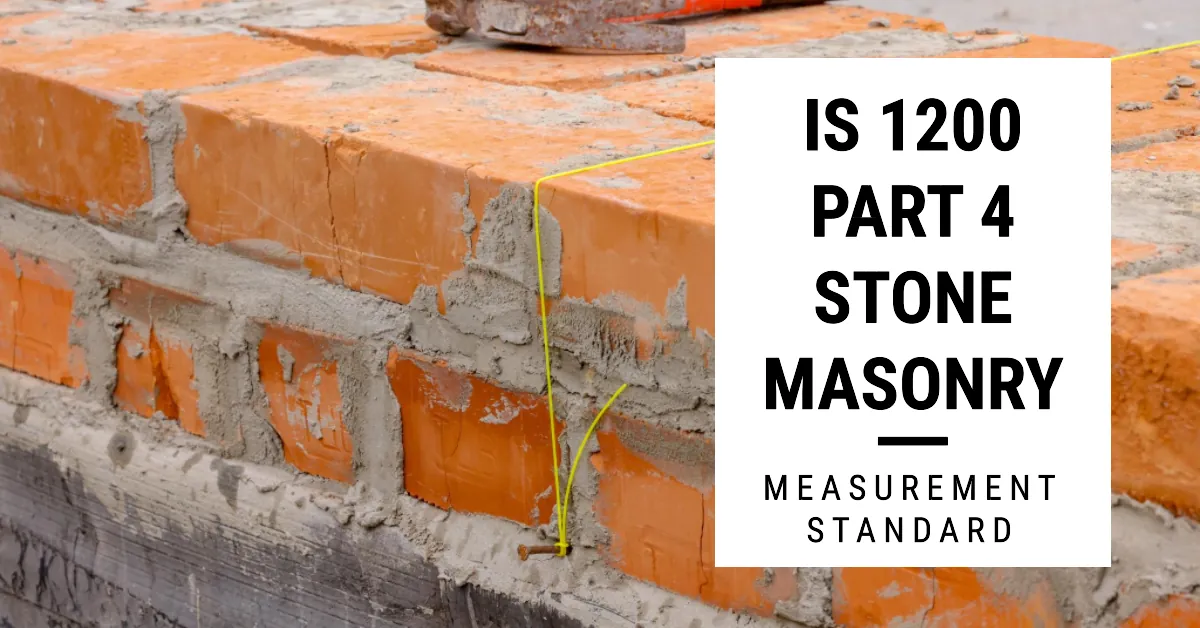IS 1200 Part 4 is the fourth part of a standard of the Bureau of Indian Standards (BIS) that focuses on measurement standards for stone masonry in civil engineering projects. It is essential in planning and executing civil engineering projects, ensuring uniformity and clarity in measurements.
Stone masonry is an essential part of civil engineering projects. It is used in the construction of foundations, walls, and other structures. The quality of stone masonry is critical to the safety and durability of these structures.
Download IS 1200 Part 4 PDF
Get the latest Indian Standard on stone masonry in PDF format.
For a detailed breakdown and direct access to all parts of the IS 1200 standard, you can refer to our page: IS 1200 All Parts PDF.
Measurement Significance
Measurement is crucial in every phase of a civil engineering project, from initial estimates to project completion and payment settlement.
However, the methods for measurement have historically lacked uniformity, leading to variations between construction agencies and government departments.
IS 1200 Part 4 addresses this issue by promoting uniformity at the technical level, facilitating better collaboration and understanding among stakeholders.
Evolution of the Standard
The standard’s journey began with a focus on building works in 1958, followed by a revision in 1964. However, as its usage expanded, it became necessary to include other civil engineering works like industrial and river valley projects. To accommodate this expansion, the standard was divided into parts, each focusing on specific trades.
Scope of Part IV
Part IV of IS 1200 covers the method of measurement for stone masonry in both building and civil engineering projects.
Stone masonry types
The standard covers a wide range of stone masonry types, including:
- Rubble masonry
- Ashlar masonry
- Coursed masonry
- Random masonry
- Dry stone masonry
General Measurement Rules
The standard establishes general rules for measurement:
- User can club Items together with detailed descriptions.
- Bill of quantities/items of work should fully describe materials and workmanship.
- The description of each item includes all necessary components.
- Dimensions are measured in the decimal system with specific rounding rules.
- Booking dimensions follow a consistent order: length, width, height, depth, or thickness.
- Certain types of work, like underwater work, must be measured separately.
- Work is categorized as below ground/datum level and above ground/datum level.
Also Read: IS 1200 Part 1 (Earthworks) Measurement Standard in Civil
Specifics for Stone Masonry Work
For stone masonry works, IS 1200 Part 4 provides details on measurement methods, stone types, bonding patterns, and joint types.
Some of the specific topics covered by IS code 1200 Part 4 include:
- Measurement of stone masonry for various types of structures, such as foundations, walls, and arches
- Measurement of stone types, such as granite, limestone, and sandstone
- Measurement of bonding patterns, such as Flemish bond, English bond, and garden wall bond
- Measurement of joint types, such as mortar joints, dry joints, and pointed joints
IS 1200 Part 4 Usage
Civil engineers, quantity surveyors, and other professionals involved in construction use IS code 1200 Part 4 as a reliable reference to measure and estimate material quantities accurately.
Usage of how IS 1200 Part 4 in practice:
- Preparing bills of quantities
- Preparing estimates
- Preparing construction contracts
IS 1200 Part 4 is an essential tool for any civil engineer or other professional involved in the construction industry.
Download IS 1200 Part 4 in PDF format and see the details.
Also Read: IS 1200 Part 2 (Concrete Works) Measurement Standard in Civil
Conclusion
IS 1200 Part 4 is an essential standard for the measurement of stone masonry in civil engineering projects. It promotes uniformity and clarity in measurements, ensuring the successful completion of any building or civil engineering project.

